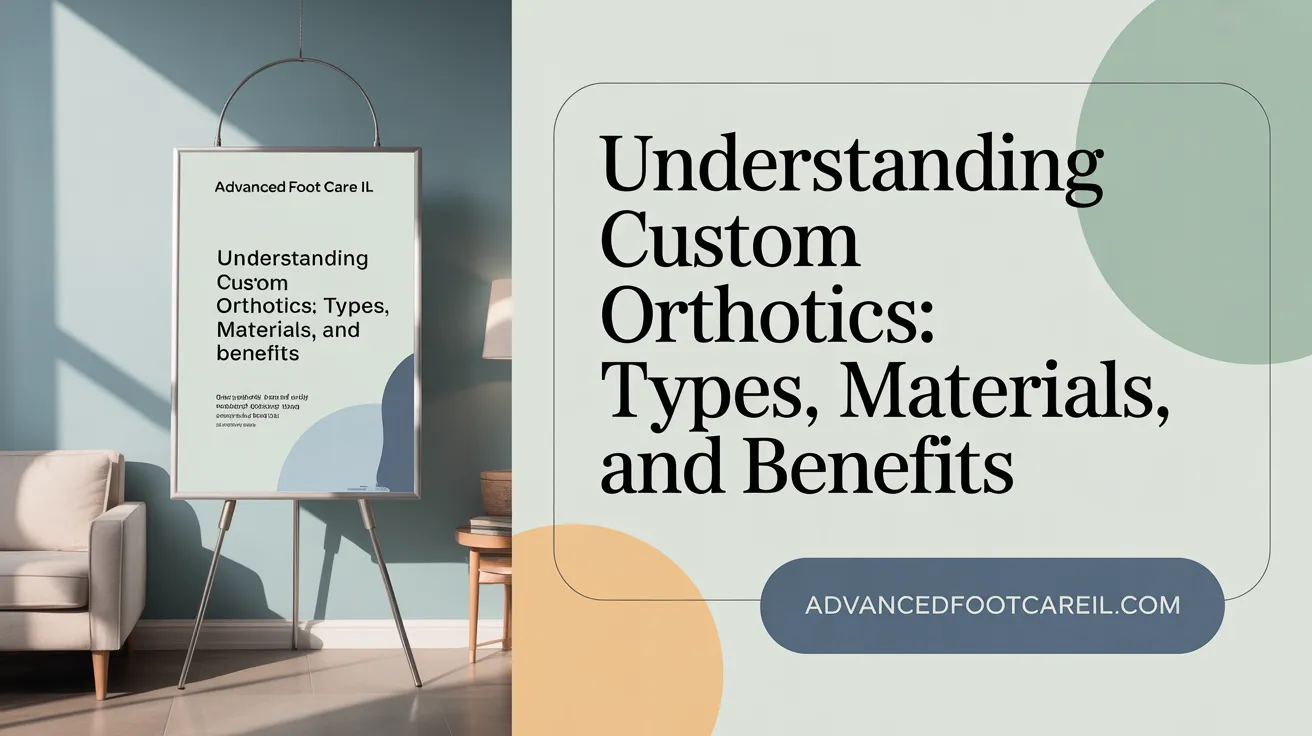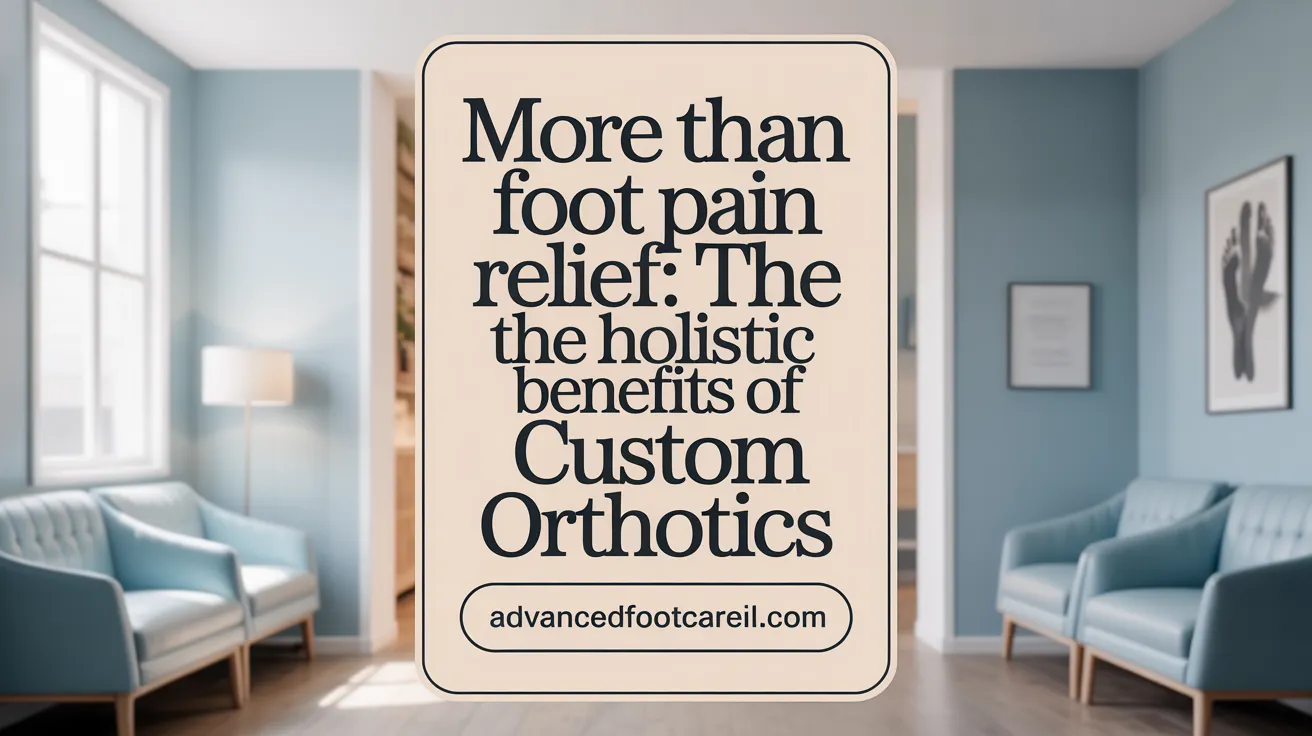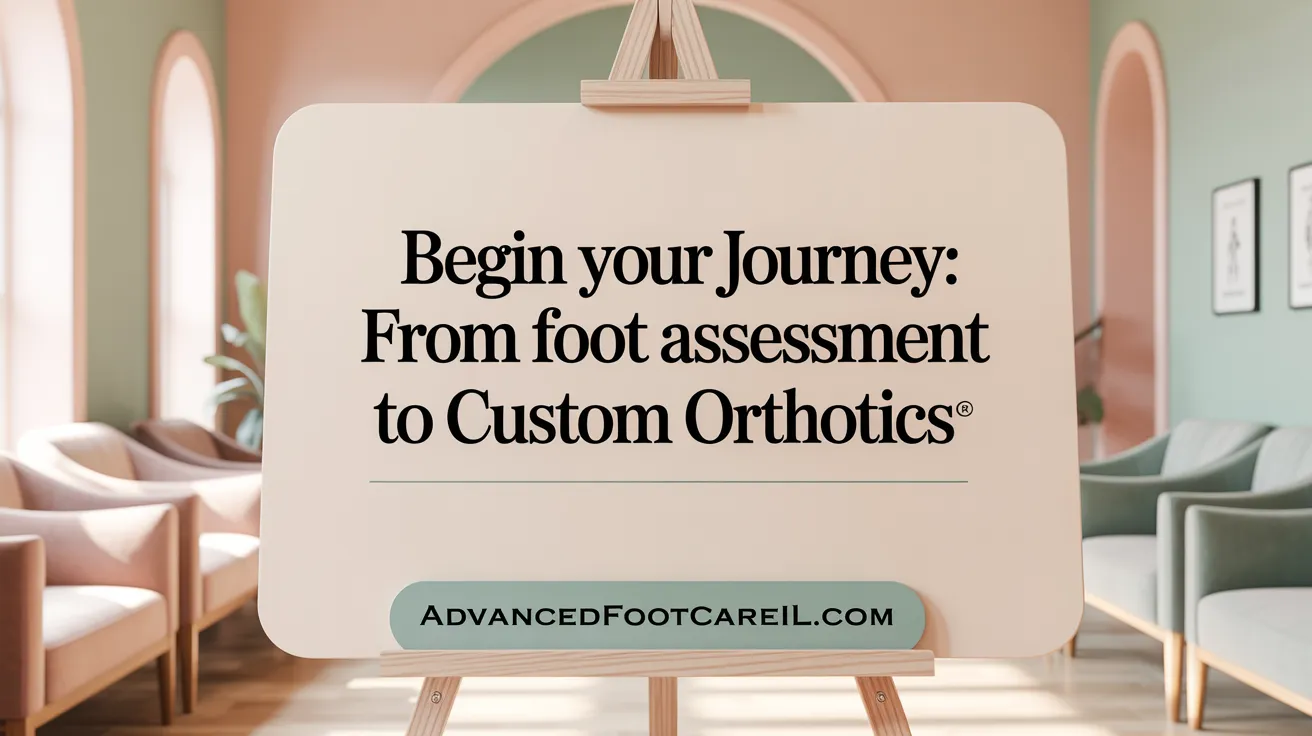Why Custom Orthotics Are Essential for Optimal Foot Support
Definition and Purpose of Custom Orthotics
Custom orthotics are specially designed shoe inserts tailored to an individual's unique foot shape, structure, and needs. Created using precise measurements from molds or 3D scans, these medical-grade devices provide targeted support and cushioning to improve foot alignment, redistribute pressure, and alleviate pain associated with conditions like plantar fasciitis, flat feet, high arches, arthritis, and diabetic neuropathy.
Differences Between Custom and Over-the-Counter Options
Unlike generic over-the-counter insoles, custom orthotics are crafted specifically for each patient based on thorough assessments by podiatrists or foot care specialists. This personalized approach ensures a perfect fit that addresses biomechanical imbalances and gait abnormalities effectively. Over-the-counter inserts offer convenience but generally provide limited support and may fail to correct structural issues or prevent injury.
Who Benefits from Custom Orthotics
Custom orthotics benefit a wide range of individuals, including those suffering from chronic foot pain, deformities such as bunions or hammertoes, athletes seeking performance enhancement and injury prevention, and people with medical conditions like diabetes requiring pressure relief to avoid complications. Additionally, individuals who stand or walk extensively, and those recovering from lower limb injuries, gain significant support and comfort through customized orthotic care.
Understanding the Role and Types of Custom Orthotics

Functional vs Accommodative Orthotics
Custom orthotics are broadly categorized into functional orthotics and accommodative types. Functional orthotics, typically made from semi-rigid materials, control excessive or abnormal foot movement to alleviate pain and aid injury recovery. Accommodative orthotics, on the other hand, use soft, flexible materials to cushion and mold to the foot, providing relief especially for conditions like diabetic foot ulcers or sensitive deformities.
Conditions Treated with Orthotics
Orthotics target a variety of foot and ankle ailments, such as orthotics for plantar fasciitis and arthritis, bunions, arthritis, hammertoes, heel spurs, flat feet, high arches, and orthotics for diabetic foot care. They also support recovery from injuries like tendonitis and shin splints by improving stabilization and proper alignment.
Materials and Manufacturing Process
Custom orthotics are crafted from durable materials like EVA foam orthotics, polypropylene orthotics, carbon fiber orthotics depending on the patient’s needs. The creation process involves a precise assessment using 3D digital scanning, foam impressions, or plaster molds. These ensure the orthotic fits perfectly and supports the foot structure anatomically.
How Orthotics Correct Gait and Alignment
Orthotics correct foot biomechanics by redistributing pressure evenly across the foot and controlling abnormal movements like overpronation or supination. This realignment positively affects the entire lower limb kinetic chain, reducing undue strain on knees, hips, and the lower back while enhancing overall posture and stability. By correcting gait irregularities, orthotics prevent further injuries and alleviate chronic pain. See correcting abnormal gait with custom orthotics for more.
The Comprehensive Benefits of Custom Orthotics Beyond Foot Pain Relief

How Do Custom Orthotics Provide Pain Relief?
Custom orthotics are expertly designed medical devices molded to the unique contours of an individual’s feet. They provide targeted support and cushioning that effectively alleviate pain caused by a range of conditions including plantar fasciitis, bunions, arthritis, high arches, flat feet, hammertoes, and calluses. By redistributing pressure and correcting abnormal foot mechanics, these orthotics reduce discomfort not only in the feet but also in associated joints such as knees and hips (Benefits of custom orthotics, Orthotics for plantar fasciitis and arthritis, Custom foot orthotics).
Can Custom Orthotics Improve Posture and Body Alignment?
Yes, custom orthotics play a vital role in enhancing overall posture and body alignment. By offering proper structural support and correcting biomechanical imbalances such as overpronation or supination, these devices optimize foot and ankle alignment. This improved foundation reduces strain on the knees, hips, and lower back, promoting better spinal health and preventing compensatory injuries (Custom orthotics designed for individual foot shape, Correcting abnormal gait with custom orthotics, Orthotics overview).
In What Ways Do Orthotics Enhance Athletic Performance?
Athletes benefit significantly from custom orthotics through improved stability, shock absorption, and alignment of the feet and ankles. These enhancements facilitate better balance and energy transfer during dynamic movements, leading to increased agility and reduced risk of common sports injuries like shin splints. Custom orthotics also provide targeted cushioning that improves endurance and performance over time (Enhancing Athletic Performance with Custom Orthotics, Sports Custom Orthotics, Custom orthotics for athletes).
How Do Orthotics Support Injury Prevention and Recovery?
Custom orthotics aid in preventing injuries by stabilizing foot motion and distributing weight evenly, effectively reducing localized stress on bones, ligaments, and tendons. They also support recovery from lower extremity injuries such as tendonitis and shin splints by stabilizing the foot, minimizing harmful strain, and facilitating proper alignment during healing. Their role as a shock absorber further protects vulnerable tissues from re-injury (Orthotics for lower extremity injury recovery, Orthotics for injury prevention, Custom-made foot and ankle orthotics).
What Are the Long-Term Foot Health Benefits?
Investing in custom orthotics offers durable, personalized support that helps prevent the progression of foot deformities and chronic conditions. They maintain foot function by correcting gait abnormalities and reducing the likelihood of secondary issues such as joint degeneration. Furthermore, orthotics contribute to sustained comfort and reduced fatigue, supporting mobility and quality of life over the long term (Benefits of custom orthotics, Long-term use of orthotics, Custom Orthotics Benefits).
The Patient Experience: From Assessment to Wearing Custom Orthotics

Diagnostic Process Including Gait Analysis and 3D Imaging
The journey to custom orthotics begins with a thorough assessment by a podiatrist or foot care specialist. This diagnostic process often includes gait analysis, where the patient's walking and foot movement patterns are carefully observed. Advanced technology such as 3D scanning or digital imaging is used to capture precise contours and biomechanics of the feet. This detailed data ensures an accurate and personalized orthotic design tailored to each patient's unique foot structure and needs.
Custom Fitting and Manufacturing Turnaround Times
After assessment, the foot impressions or digital scans are sent to specialized labs for custom orthotic fabrication. Most custom orthotics are manufactured within two to three weeks, with some clinics offering even faster in-house production. The process involves selecting appropriate materials—rigid for support or soft for cushioning—based on clinical findings and patient lifestyle. Custom fitting ensures the orthotics snugly fit inside a patient’s shoes discreetly and comfortably.
Adjustment and Break-In Periods
Initial use of new custom orthotics may cause mild discomfort as the feet adjust. Patients are advised to follow a gradual break-in schedule starting with wearing the orthotics for one hour per day and increasing time daily over several weeks. Typically, most patients notice significant comfort and symptom improvement within the first month. Monitoring for any pain or irritation during this period is essential, with follow-up consultations allowing adjustments to optimize fit and function.
Care and Maintenance of Orthotics
Custom orthotics are durable but require proper care to maintain effectiveness. Cleaning should be done regularly with mild soap or alcohol wipes, followed by air drying. Avoiding excess moisture and direct heat extends their lifespan, generally lasting between two to five years depending on usage and material quality. Routine checks ensure the orthotics retain their shape and functionality.
Insurance and Payment Options
Coverage for custom orthotics varies by insurance plan. Patients are encouraged to verify their benefits beforehand. Payment options often include flexible spending accounts (FSA), health savings accounts (HSA), medical IRAs, cash, checks, credit cards, and financing plans like CareCredit. Transparent communication about costs and insurance helps patients make informed decisions on investing in their foot health.
Tailoring Orthotics for Specific Needs: Diabetic Care, Sports, and Professional Use

Custom Orthotics for Diabetes-Related Foot Issues
Custom orthotics for diabetic patients are designed to accommodate specific needs related to neuropathy and the prevention of serious complications like ulcers, blisters, and calluses. These orthotics redistribute pressure evenly across the foot, reducing stress on vulnerable areas. They provide targeted cushioning and improve foot alignment, which helps prevent the progression of deformities and promotes skin integrity. They are crafted using precise 3D imaging and molds, ensuring a tailored fit that supports foot health and mobility for individuals with diabetes (Custom orthotics for diabetic foot care, Orthotics for diabetes-related neuropathy, Custom Foot Orthotics.
Sport-Specific Orthotic Benefits and Prescriptions
Athletes benefit significantly from custom orthotics designed specifically for their sport. These devices offer enhanced shock absorption, stability, and biomechanical support, which can improve performance and prevent injuries such as shin splints, plantar fasciitis, and stress fractures. Orthotics are prescribed based on a thorough gait analysis and foot assessment to match the athlete’s unique movement patterns and sport-specific demands. Durable materials and specialized designs ensure these orthotics withstand rigorous activity while providing optimal support (Custom orthotics for athletes, Sports Custom Orthotics, Custom Foot Orthotics).
Support for Occupational Foot Stress
For individuals whose occupations involve prolonged standing or repetitive foot strain, custom orthotics provide essential support and pressure redistribution. Orthotics alleviate foot fatigue, reduce pain associated with conditions like bunions and plantar fasciitis, and improve overall foot alignment. These devices help prevent the development or worsening of foot deformities by stabilizing joints and balancing weight distribution during prolonged work activities (Weight distribution and balance with orthotics, Orthotics for foot and ankle pain, Custom Orthotics).
Specialized Orthotics for Deformities Like Bunions and Hammertoes
Custom orthotics are tailored to address specific foot deformities such as bunions and hammertoes. They function by redistributing pressure away from deformities, reducing friction and irritation. Ingredients such as toe separators and bunion shields are incorporated into the orthotic design when necessary. By improving foot biomechanics and alignment, these orthotics slow deformity progression and provide pain relief, enhancing mobility and quality of life (Bunion shields for bunion relief, Toe separators for corns and calluses, Orthotics for musculoskeletal support).
By customizing orthotics to meet diverse needs—from diabetic care to athletic and occupational support and correction of deformities—patients receive targeted treatment that optimizes foot function and overall well-being (Benefits of custom orthotics, Custom orthotics design process, Custom Orthotics Benefits.
Integrating Custom Orthotics with Minimally Invasive Foot Surgery and Comprehensive Care
How Do Orthotics Complement Surgical Treatments?
Custom orthotics play a vital role in enhancing surgical outcomes for foot and ankle conditions. After minimally invasive foot surgery, such as bunion correction or hammertoe repair, orthotics help maintain correct foot alignment and redistribute pressure evenly across the feet. This prevents undue stress on healing areas and helps reduce the risk of deformity recurrence. They support shock absorption and provide stability, allowing for safer and more effective rehabilitation. For more on custom orthotics in post-surgical recovery, see detailed resources.
What Are the Benefits of Minimally Invasive Surgery?
Minimally invasive foot surgery involves small incisions and precise bone osteotomies, resulting in less tissue damage compared to traditional surgery. Patients benefit from reduced pain, minimal scarring, decreased swelling, faster recovery times, and earlier return to weight-bearing activities. Techniques like Percutaneous Chevron Akin and Lapidus ensure deformities are corrected with high accuracy while preserving surrounding soft tissues. Explore comprehensive insights on minimally invasive foot surgery.
How Are Orthotics Used in Post-Surgical Rehabilitation?
Postoperative use of custom orthotics supports foot function during recovery by stabilizing the foot and controlling abnormal gait mechanics that could impede healing. Orthotics aid in gradual weight distribution and provide cushioning to sensitive areas, promoting comfort and mobility. They are often prescribed to continue long-term support, preventing complications and ensuring sustainable alignment benefits from the surgical correction. For more on orthotics and post-surgical rehabilitation, visit specialized care sites.
What Constitutes a Holistic Approach to Foot and Ankle Health?
Comprehensive care combines minimally invasive foot surgery techniques with customized orthotic interventions for optimal outcomes. This integrated strategy includes thorough biomechanical assessments, gait analysis, and patient education on footwear, foot hygiene, and exercises to strengthen foot musculature. Regular follow-up enables adjustment of orthotics and care plans to address evolving needs, supporting joint health not only locally but along the kinetic chain involving knees, hips, and spine. Learn more about holistic foot care approaches and integrative strategies for musculoskeletal health.
Investing in Custom Orthotics: A Step Towards Lasting Foot Health and Comfort
Custom orthotics offer tailored support that addresses specific foot issues such as plantar fasciitis, flat feet, and bunions, providing pain relief and improving alignment.
Their personalized design ensures optimal fit, aligning the feet correctly and balancing weight distribution to enhance overall mobility and prevent future problems.
Consulting podiatry specialists for custom orthotics guarantees professional assessment and precise fabrication, maximizing treatment effectiveness and long-term foot health.
